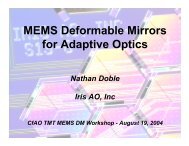PSF reconstruction for Keck AO - Laboratory for Adaptive Optics
PSF reconstruction for Keck AO - Laboratory for Adaptive Optics
PSF reconstruction for Keck AO - Laboratory for Adaptive Optics
You also want an ePaper? Increase the reach of your titles
YUMPU automatically turns print PDFs into web optimized ePapers that Google loves.
3 COMPONENT MODELING 15Figure 2: Fitting error OTFs, <strong>PSF</strong>s and structure functions, comparing the Monte Carlo simulation and the analyticalcalculation (53). Right: structure functions <strong>for</strong> the Monte Carlo (black curve) and analytical (red curve) method. Top left:OTFs by the Monte Carlo simulation (left) and the analytical approximation (right). Bottom left: <strong>PSF</strong>s (including thetelescope kernel) from the Monte Carlo simulation (left) and in the analytical approximation (right).Monte Carlo simulationThe filter function H(f) was obtained numerically by computing both Φ and Φ ⊥ explicitly in a numerical MonteCarlo simulation of the K2 <strong>AO</strong> system, and taking the ratio of the two as in (52). H(f) will in practice not dependon any of the turbulence parameters r 0 , L 0 or Cn 2 of the von Karman turbulence model, but only on the shape andarrangement of the influence functions h, and so we only need to pre-compute one filter function H <strong>for</strong> each platescale and <strong>PSF</strong> <strong>reconstruction</strong> grid scale that we want to use. For K2 <strong>AO</strong> this means 4-5 separate filter functionswhich only need to be computed once.To avoid edge-effects in the simulation I used periodic random phase screens generated by the FFT method andper<strong>for</strong>med the fitting of the influence functions using an extended actuator grid, covering the entire phase screen.Using a relatively small computational grid this still required 1600 actuators, the central 325 of which belonged toa D = 10 m telescope pupil, and the rest only provide boundary conditions (i.e. covering the entire screen withactuators eliminates boundaries altogether). The influence functions used were of the Y<strong>AO</strong> type (section 3.3) with20% cross-coupling.The simulation ran <strong>for</strong> 50000 iterations over 5000 independently generated screens, where each screen was loopedover <strong>for</strong> 10 frames while shifting the screen a few pixels. The PSDs are shown in Fig. 1, where the total inputturbulence phase variance was σφ 2 =10.3 rad2 , and the residual fitting error phase variance was σφ 2 ⊥=0.224 rad 2 .Since d/r 0 = 1 this implies a coefficient a F =0.224 which appears to be underestimating the fitting error if thecorrect coefficient should be a F =0.28 (though we might as well question this number instead). We may expect thatthis simulation would underestimates the fitting error slightly, since we used a relatively coarse sampling of only 4pixels per actuator pitch (which cuts off some input power from the PSD). Fig. 2 shows fitting error OTFs, <strong>PSF</strong>sand structure functions, comparing the Monte Carlo simulation with method 3 of computing the fitting error, i.e. abinary mask on the turbulence PSD. It is seen that using a sharp mask on Φ is going to overemphasize the ringingin the structure function and the OTF, and produce a too sharp inner working region of the <strong>PSF</strong>. The effect on theStrehl of the FWHM is negligible, but the detailed structure of the <strong>PSF</strong> halo is clearly affected by the exact shapeof the PSD mask.3.3 DM modelThe model of DM influence functions h i (x) is relevant in several places in the <strong>PSF</strong> <strong>reconstruction</strong> algorithm. Theydefine the basis of controlled modes (3) <strong>for</strong> the residual error structure function (12), and thus determine how WFSsignals (including noise, aliasing and turbulence) are propagated into wavefront errors; they define the filter function<strong>for</strong> the fitting error, and in some anisoplanatism models define the anisoplanatism error propagated onto controlled



